[press release]
New Special Stamps from Royal Mail Celebrate Roman Life and Culture In Britain
- Eight new stamps explore the sophistication, technical brilliance and artistry of Roman Britain
- Featured in the set are: Dover Lighthouse; Bignor mosaic; Caerleon Amphitheatre; Ribchester helmet; Bridgeness distance slab; Warrior god, Cambridgeshire; Gorgon’s head, Bath; and Hadrian’s Wall
- For almost 400 years, much of mainland Britain was a province of the Roman Empire
- Royal Mail worked with the British Museum in the development of the stamp issue
- A full set of all eight stamps, available in a Presentation Pack, retails at £10.35
- The stamps and a range of collectible products are available to order now at www.royalmail.com/romanbritain and by phone on 03457 641 641
- The stamps will be available on general sale from Thursday 18 June
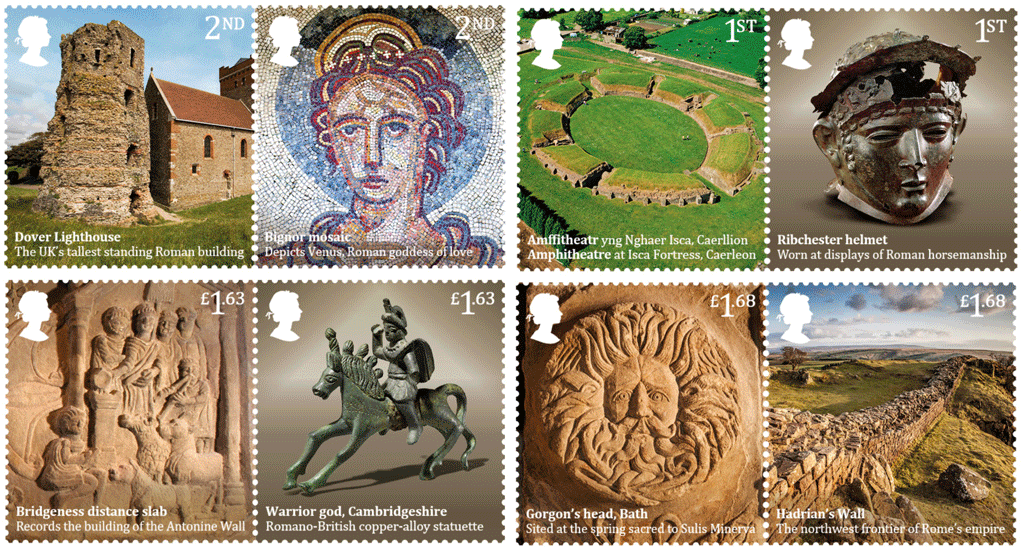
Royal Mail has revealed images from a new set of stamps being issued to celebrate Roman life and culture in Britain.
The eight stamps demonstrate the sophistication, technical brilliance and artistry of Roman Britain with images of sites and key artefacts – all of which remain in Britain today.
Featured in the set are: Dover Lighthouse; Bignor mosaic; Caerleon Amphitheatre; Ribchester helmet; Bridgeness distance slab; Warrior god, Cambridgeshire; Gorgon’s head, Bath; and Hadrian’s Wall.
Today, it is still possible to see the legacy of Rome by visiting standing remains such as Hadrian’s Wall and the amphitheatre at Newport or by seeking out the huge variety of Roman artefacts that can be viewed in museums across the UK.
Royal Mail worked with the British Museum in the development of the stamp issue.
Roman Britain:
For almost 400 years – 43 to 410 AD, much of mainland Britain was a province of the Roman empire. This period has a profound effect on British society, laws, language, art, architecture, culture and beliefs. Rome’s lasting legacy is visible in standing remains such as forts and villas and archaeological finds displayed in museums across the UK.
A large occupying army, estimated at around 55,000 men in the 2nd century, established a road network across much of lowland Britain, also facilitating the first public post system, the cursus publicus. Ermine Street, for example, linked London with Lincoln and York, three important towns.
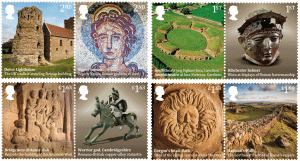 Indeed, although most Britons lived and worked in the countryside, continuing a way of life established for centuries, some settled in towns and participated in Roman social and cultural customs, such as public bathing or visiting the amphitheatre to be entertained. Wealthy landowners built villas – country residences on the Roman model, often floored with mosaics.
Indeed, although most Britons lived and worked in the countryside, continuing a way of life established for centuries, some settled in towns and participated in Roman social and cultural customs, such as public bathing or visiting the amphitheatre to be entertained. Wealthy landowners built villas – country residences on the Roman model, often floored with mosaics.
The economy was vibrant, with artisans producing everything from pottery beakers to iron tools, leather shoes and beer. Britain exported grain and metals, and slaves too, and imported goods from around the Mediterranean and beyond.
Tombstones and other inscriptions provide evidence of incomers from Italy and Rome’s European and eastern-Mediterranean provinces, and over time a distinctive Romano-British culture developed, as seen in objects such as brooches unique to Britain. Roman gods were worshipped alongside local deities, and Eastern mystery cults, and Christianity, were also popular.
Richard Hobbs, the Weston Curator of Roman Britain at the British Museum, said: “It was a great honour to work with Royal Mail on this project. The eight sites and objects chosen give a taste of life in Roman Britain, which I hope will encourage people to explore this fascinating period in Britain’s history further. The Ribchester helmet is not only one of the British Museum’s iconic items, but also one of our earliest acquisitions – it’s been in the national collection since 1796, when a hoard of Roman military equipment was discovered in Ribchester, Lancashire. The helmet, decorated with a scene of a battle between infantry and cavalry, was the most spectacular piece.”
Philip Parker, Royal Mail spokesperson, said: “What did the Romans do for us? They gave us important new towns, a network of roads to link them, vast building works in stone, a new language and our calendar – they even named the country, ‘Britain’. These new stamps feature some of the most complete and striking Roman sites and objects which show their character and sophistication.”
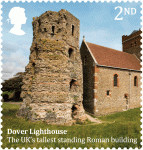 Dover Lighthouse
Dover Lighthouse
The Roman lighthouse – pharos – that adjoins the church of St Mary in the grounds of Dover Castle is the tallest surviving Roman building in Britain. Possibly modelled on the Pharos at Alexandria in Egypt, it probably stood to a height of around 24m. When it was in use, a beacon of fire would have been lit at night to guide ships in the Channel.
Bignor Mosaic
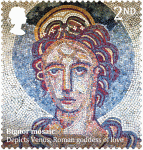 The Roman villa at Bignor, West Sussex, discovered in 1811 during ploughing, has some of the finest preserved mosaics from Roman Britain. The mosaic featured on the stamp, laid in an apsed room on the villa’s north side, probably dates to the early 4th century AD. It depicts a female head usually identified as the Roman goddess Venus.
The Roman villa at Bignor, West Sussex, discovered in 1811 during ploughing, has some of the finest preserved mosaics from Roman Britain. The mosaic featured on the stamp, laid in an apsed room on the villa’s north side, probably dates to the early 4th century AD. It depicts a female head usually identified as the Roman goddess Venus.
Amphitheatre, Caerleon
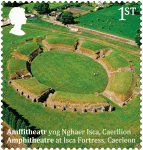 The amphitheatre at Caerleon (Isca) in southeast Wales (now in the north of the city of Newport) is the most complete to survive in Britain. It was built around AD 80, some years after the establishment of the nearby legionary fortress occupied by the Second Legion Augusta. The amphitheatre has a probable beast pen (carcer), in which animals and possibly humans were kept before their turn in the arena.
The amphitheatre at Caerleon (Isca) in southeast Wales (now in the north of the city of Newport) is the most complete to survive in Britain. It was built around AD 80, some years after the establishment of the nearby legionary fortress occupied by the Second Legion Augusta. The amphitheatre has a probable beast pen (carcer), in which animals and possibly humans were kept before their turn in the arena.
Ribchester Helmet
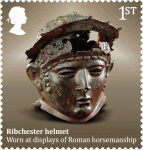 Discovered by a clogmaker’s son in 1796 at Ribchester, Lancashire, this helmet is one of the finest surviving examples of its type from anywhere in the Empire. It was worn by an expert cavalryman during cavalry sports events (hippika gymnasia) – flamboyant displays of military horsemanship and mounted weapons drill of great skill and timing. It is displayed at The British Museum.
Discovered by a clogmaker’s son in 1796 at Ribchester, Lancashire, this helmet is one of the finest surviving examples of its type from anywhere in the Empire. It was worn by an expert cavalryman during cavalry sports events (hippika gymnasia) – flamboyant displays of military horsemanship and mounted weapons drill of great skill and timing. It is displayed at The British Museum.
Bridgeness Distance Slab
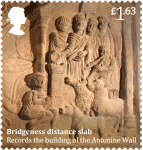 The Bridgeness distance slab at the eastern end of the Antonine Wall records its building by the Second Legion Augusta and documents the distance erected. The construction of the wall, primarily in turf, was ordered by Antoninus Pius in AD 138, and the wall ran from the Firth of Forth to the Firth of Clyde. It was occupied for only about 20 years. It is displayed at the National Museum of Scotland in Edinburgh.
The Bridgeness distance slab at the eastern end of the Antonine Wall records its building by the Second Legion Augusta and documents the distance erected. The construction of the wall, primarily in turf, was ordered by Antoninus Pius in AD 138, and the wall ran from the Firth of Forth to the Firth of Clyde. It was occupied for only about 20 years. It is displayed at the National Museum of Scotland in Edinburgh.
Warrior God
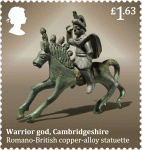 This attractive copper-alloy fgurine was discovered at Stow-cum-Quy in Cambridgeshire. Dating from the 3rd or 4th centuries AD, it depicts a helmeted rider on horseback who originally would have held a spear in his raised hand. The 8cm high figure is probably that of a local rider-god associated with Roman Mars and may have belonged to a shrine dedicated to the god. It is displayed at The British Museum.
This attractive copper-alloy fgurine was discovered at Stow-cum-Quy in Cambridgeshire. Dating from the 3rd or 4th centuries AD, it depicts a helmeted rider on horseback who originally would have held a spear in his raised hand. The 8cm high figure is probably that of a local rider-god associated with Roman Mars and may have belonged to a shrine dedicated to the god. It is displayed at The British Museum.
Gorgon’s Head
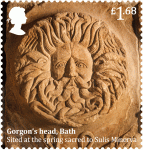 One of the most striking pieces of stone sculpture to survive from Roman Britain, this head occupied the pediment of the temple to Sulis Minerva at Bath, where it was set on a shield held aloft by Victories. An unusual portrayal of a male Gorgon, it also has echoes of Oceanus, the god of the oceans, an appropriate image for the sacred spring at the Roman Baths.
One of the most striking pieces of stone sculpture to survive from Roman Britain, this head occupied the pediment of the temple to Sulis Minerva at Bath, where it was set on a shield held aloft by Victories. An unusual portrayal of a male Gorgon, it also has echoes of Oceanus, the god of the oceans, an appropriate image for the sacred spring at the Roman Baths.
Hadrian’s Wall
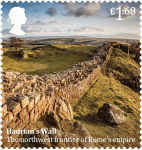 Hadrian’s Wall is the largest surviving Roman-era monument in Britain. Its construction followed Emperor Hadrian’s visit to the province in AD 122. A stone wall with milecastles, forts and a ditch, it formed a continuous barrier running from the River Tyne at Newcastle to Bowness on the Solway. Its likely purpose was to control tribal activity on both sides of the frontier.
Hadrian’s Wall is the largest surviving Roman-era monument in Britain. Its construction followed Emperor Hadrian’s visit to the province in AD 122. A stone wall with milecastles, forts and a ditch, it formed a continuous barrier running from the River Tyne at Newcastle to Bowness on the Solway. Its likely purpose was to control tribal activity on both sides of the frontier.
The full range of stamps, and other collectible products are available now at www.royalmail.com/romanbritain and by phone on 03457 641 641.
The full set of eight stamps, available in a Presentation Pack, retails at £10.35.
The stamps will go on general sale from 18 June 2020.
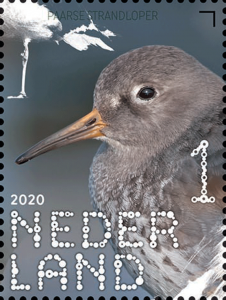 The Hague, June 15, 2020 – The dune and coastal area of the Netherlands is the breeding ground for a large part of the Dutch breeding birds. You can also see bird species that are found nowhere else in the Netherlands. Today, 10 stamps from the series “Experience nature” show 10 beautiful, but endangered shorebirds.
The Hague, June 15, 2020 – The dune and coastal area of the Netherlands is the breeding ground for a large part of the Dutch breeding birds. You can also see bird species that are found nowhere else in the Netherlands. Today, 10 stamps from the series “Experience nature” show 10 beautiful, but endangered shorebirds.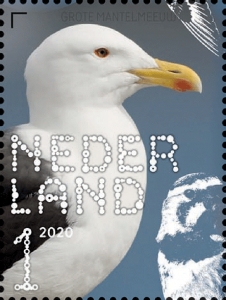 The stamps with the 10 shorebirds were designed by graphic designer Frank Janse from Gouda. Due to the summer season in which the stamps come out, the yellow of the beach and dunes dominates, with deep blue skies and the golden color of the summer sun. Janse: “I also selected the photos for that. I did not have to edit the colors, because they were already there. The strong background colors contrast nicely with the drawing of the birds. They are predominantly white, black and gray, with some yellow and red accents on the beach lark and snow bunting. ”
The stamps with the 10 shorebirds were designed by graphic designer Frank Janse from Gouda. Due to the summer season in which the stamps come out, the yellow of the beach and dunes dominates, with deep blue skies and the golden color of the summer sun. Janse: “I also selected the photos for that. I did not have to edit the colors, because they were already there. The strong background colors contrast nicely with the drawing of the birds. They are predominantly white, black and gray, with some yellow and red accents on the beach lark and snow bunting. ”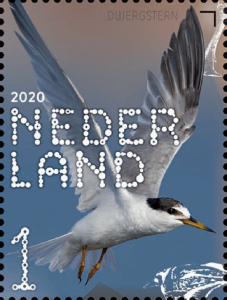 Mail, says that the birds in our country are indeed not doing well. “For example, 87 bird species are on the red list of breeding birds. That is 44% of all species that breed in our country. 10 species are critically endangered, such as the short-eared owl and the forest monkey. ”
Mail, says that the birds in our country are indeed not doing well. “For example, 87 bird species are on the red list of breeding birds. That is 44% of all species that breed in our country. 10 species are critically endangered, such as the short-eared owl and the forest monkey. ”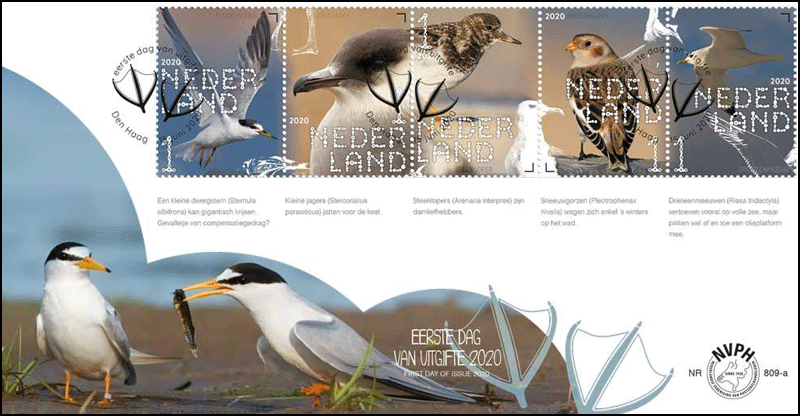
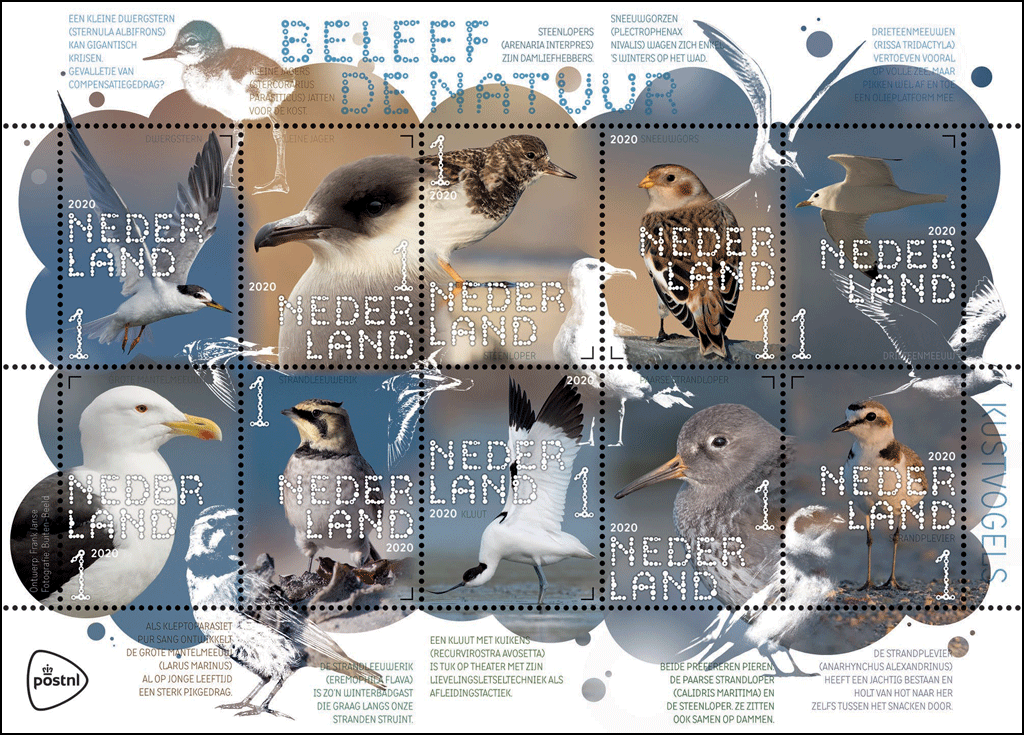

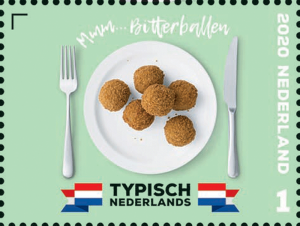 The Hague, June 15, 2020 – The latest stamps from the Typical Dutch series depict the traditional bitterbal. This round version of the croquette used to be eaten with a bitter, a strong alcoholic herbal drink like gin.
The Hague, June 15, 2020 – The latest stamps from the Typical Dutch series depict the traditional bitterbal. This round version of the croquette used to be eaten with a bitter, a strong alcoholic herbal drink like gin.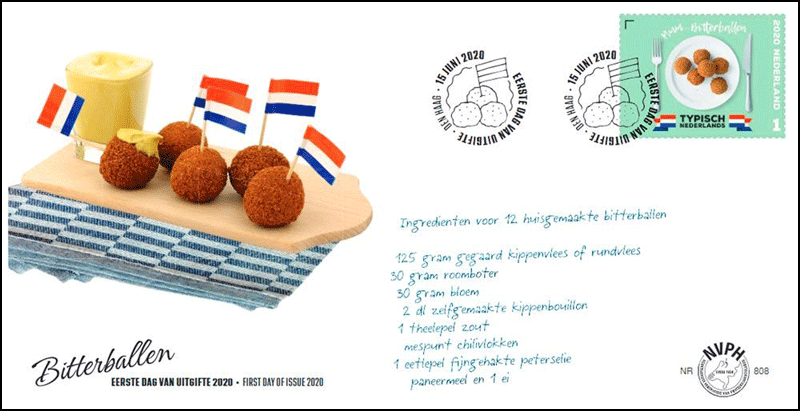
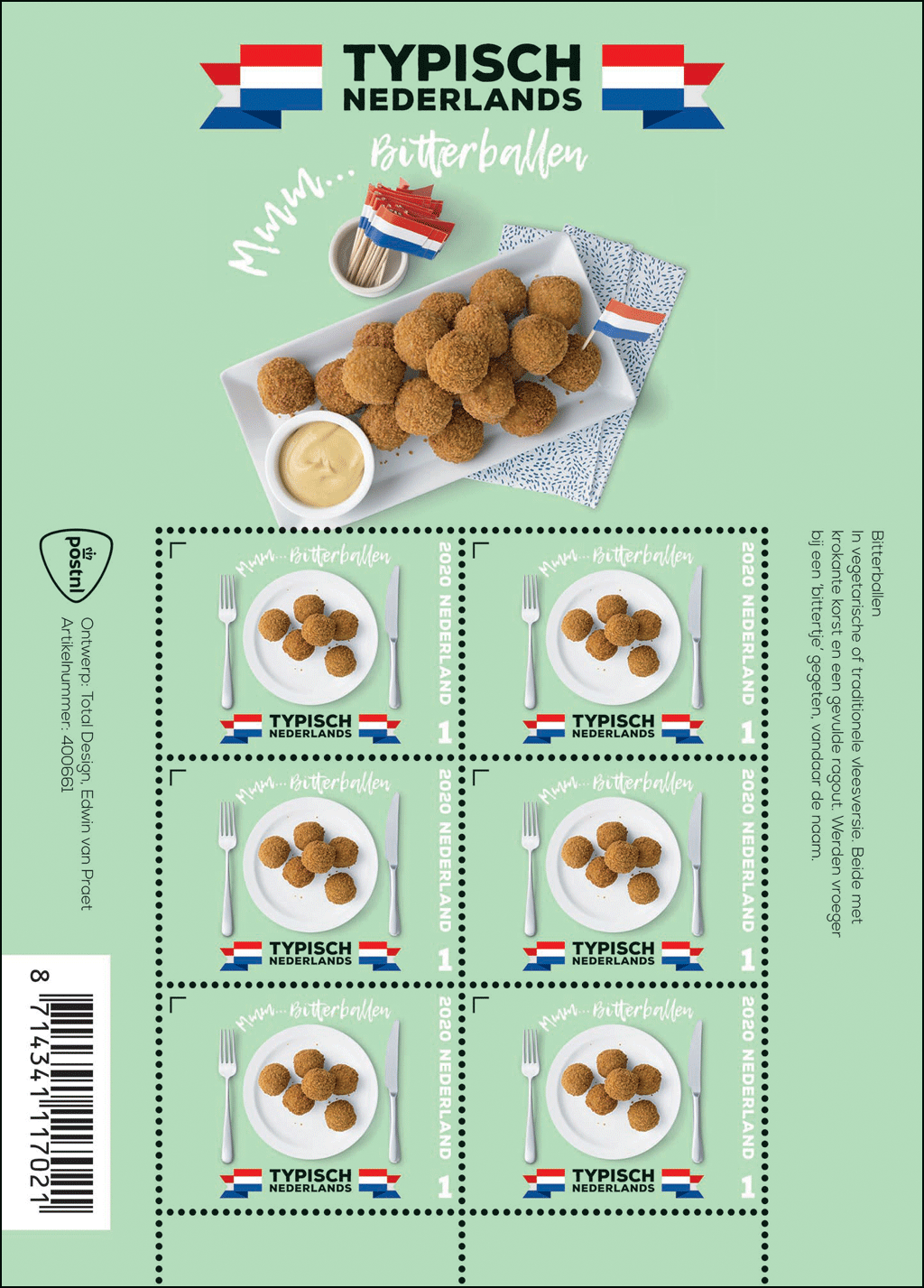
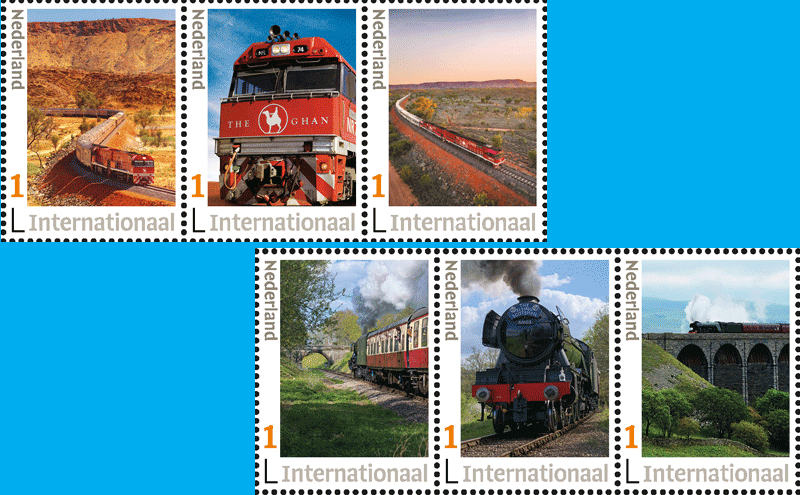 The Hague, June 15, 2020 – With the personal stamps from the Trains & Tracks series, PostNL pays extensive attention to unique train routes around the world. Last week the stamp sheets about The Ghan and the Flying Scotsman, 2 famous rail connections in Australia and Great Britain, were published.
The Hague, June 15, 2020 – With the personal stamps from the Trains & Tracks series, PostNL pays extensive attention to unique train routes around the world. Last week the stamp sheets about The Ghan and the Flying Scotsman, 2 famous rail connections in Australia and Great Britain, were published.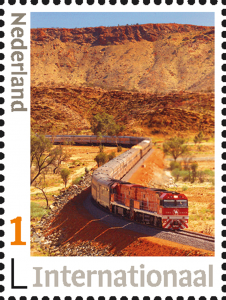
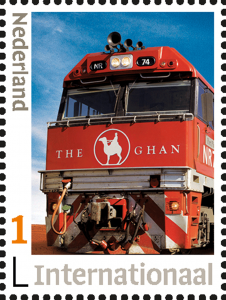 The Ghan is a train ride right through the middle of Australia. The Great Southern Rail carrier train runs from Adelaide in South Australia through the outback at Alice Springs and ends in Darwin in the Northern Territory. The name The Ghan is derived from the Afghan camels that used to be the main means of transport in this part of Australia.
The Ghan is a train ride right through the middle of Australia. The Great Southern Rail carrier train runs from Adelaide in South Australia through the outback at Alice Springs and ends in Darwin in the Northern Territory. The name The Ghan is derived from the Afghan camels that used to be the main means of transport in this part of Australia.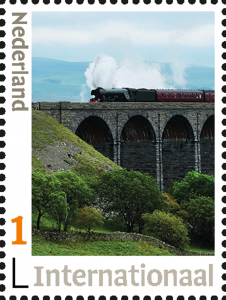
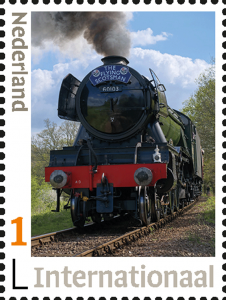 stamps every year. This program is flexible in nature. This enables PostNL to respond ad hoc to current developments and requests. Each issue is designed on the basis of a fixed format with a fixed number of personal stamps.
stamps every year. This program is flexible in nature. This enables PostNL to respond ad hoc to current developments and requests. Each issue is designed on the basis of a fixed format with a fixed number of personal stamps.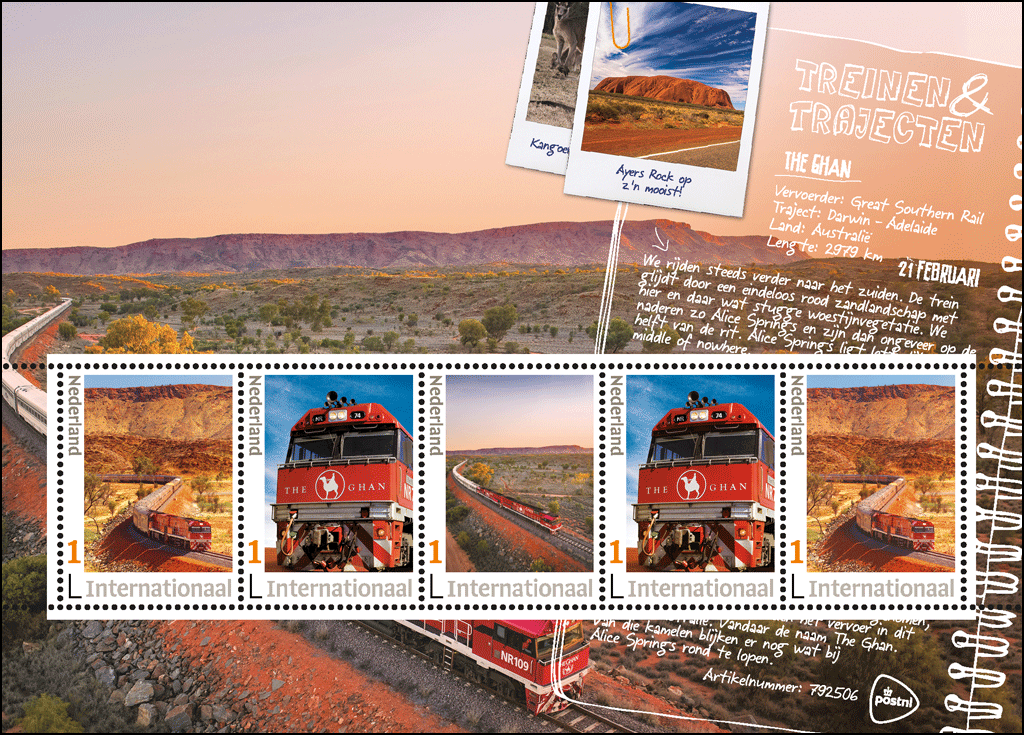
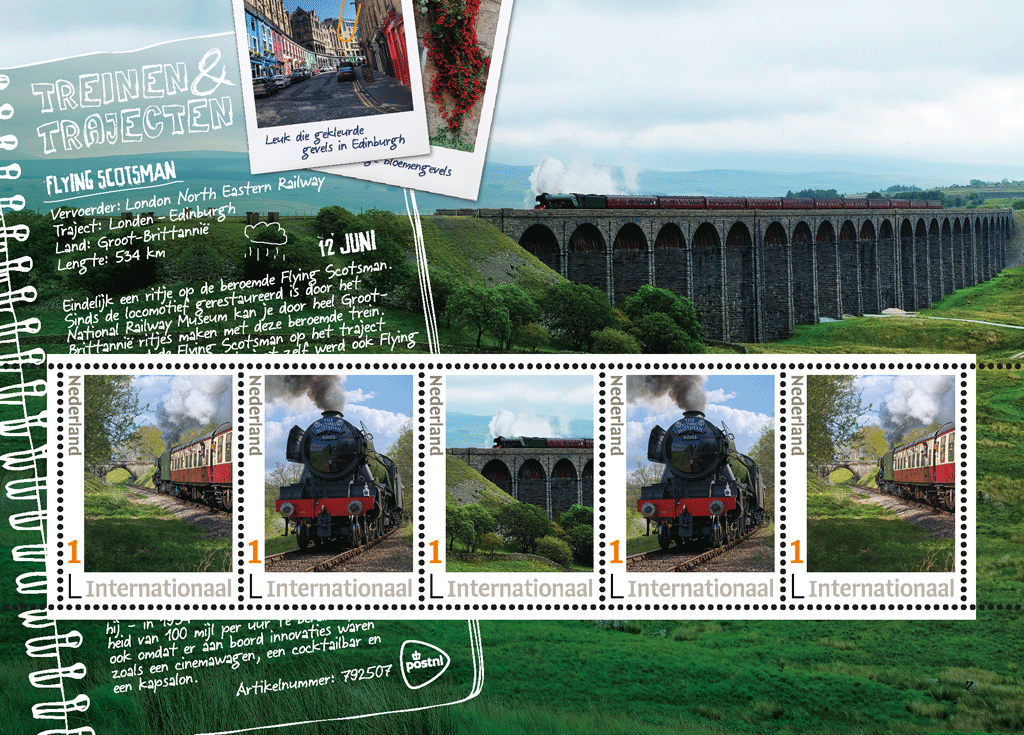

 Indeed, although most Britons lived and worked in the countryside, continuing a way of life established for centuries, some settled in towns and participated in Roman social and cultural customs, such as public bathing or visiting the amphitheatre to be entertained. Wealthy landowners built villas – country residences on the Roman model, often floored with mosaics.
Indeed, although most Britons lived and worked in the countryside, continuing a way of life established for centuries, some settled in towns and participated in Roman social and cultural customs, such as public bathing or visiting the amphitheatre to be entertained. Wealthy landowners built villas – country residences on the Roman model, often floored with mosaics.
 The Roman villa at Bignor, West Sussex, discovered in 1811 during ploughing, has some of the finest preserved mosaics from Roman Britain. The mosaic featured on the stamp, laid in an apsed room on the villa’s north side, probably dates to the early 4th century AD. It depicts a female head usually identified as the Roman goddess Venus.
The Roman villa at Bignor, West Sussex, discovered in 1811 during ploughing, has some of the finest preserved mosaics from Roman Britain. The mosaic featured on the stamp, laid in an apsed room on the villa’s north side, probably dates to the early 4th century AD. It depicts a female head usually identified as the Roman goddess Venus. The amphitheatre at Caerleon (Isca) in southeast Wales (now in the north of the city of Newport) is the most complete to survive in Britain. It was built around AD 80, some years after the establishment of the nearby legionary fortress occupied by the Second Legion Augusta. The amphitheatre has a probable beast pen (carcer), in which animals and possibly humans were kept before their turn in the arena.
The amphitheatre at Caerleon (Isca) in southeast Wales (now in the north of the city of Newport) is the most complete to survive in Britain. It was built around AD 80, some years after the establishment of the nearby legionary fortress occupied by the Second Legion Augusta. The amphitheatre has a probable beast pen (carcer), in which animals and possibly humans were kept before their turn in the arena. Discovered by a clogmaker’s son in 1796 at Ribchester, Lancashire, this helmet is one of the finest surviving examples of its type from anywhere in the Empire. It was worn by an expert cavalryman during cavalry sports events (hippika gymnasia) – flamboyant displays of military horsemanship and mounted weapons drill of great skill and timing. It is displayed at The British Museum.
Discovered by a clogmaker’s son in 1796 at Ribchester, Lancashire, this helmet is one of the finest surviving examples of its type from anywhere in the Empire. It was worn by an expert cavalryman during cavalry sports events (hippika gymnasia) – flamboyant displays of military horsemanship and mounted weapons drill of great skill and timing. It is displayed at The British Museum. The Bridgeness distance slab at the eastern end of the Antonine Wall records its building by the Second Legion Augusta and documents the distance erected. The construction of the wall, primarily in turf, was ordered by Antoninus Pius in AD 138, and the wall ran from the Firth of Forth to the Firth of Clyde. It was occupied for only about 20 years. It is displayed at the National Museum of Scotland in Edinburgh.
The Bridgeness distance slab at the eastern end of the Antonine Wall records its building by the Second Legion Augusta and documents the distance erected. The construction of the wall, primarily in turf, was ordered by Antoninus Pius in AD 138, and the wall ran from the Firth of Forth to the Firth of Clyde. It was occupied for only about 20 years. It is displayed at the National Museum of Scotland in Edinburgh. This attractive copper-alloy fgurine was discovered at Stow-cum-Quy in Cambridgeshire. Dating from the 3rd or 4th centuries AD, it depicts a helmeted rider on horseback who originally would have held a spear in his raised hand. The 8cm high figure is probably that of a local rider-god associated with Roman Mars and may have belonged to a shrine dedicated to the god. It is displayed at The British Museum.
This attractive copper-alloy fgurine was discovered at Stow-cum-Quy in Cambridgeshire. Dating from the 3rd or 4th centuries AD, it depicts a helmeted rider on horseback who originally would have held a spear in his raised hand. The 8cm high figure is probably that of a local rider-god associated with Roman Mars and may have belonged to a shrine dedicated to the god. It is displayed at The British Museum. One of the most striking pieces of stone sculpture to survive from Roman Britain, this head occupied the pediment of the temple to Sulis Minerva at Bath, where it was set on a shield held aloft by Victories. An unusual portrayal of a male Gorgon, it also has echoes of Oceanus, the god of the oceans, an appropriate image for the sacred spring at the Roman Baths.
One of the most striking pieces of stone sculpture to survive from Roman Britain, this head occupied the pediment of the temple to Sulis Minerva at Bath, where it was set on a shield held aloft by Victories. An unusual portrayal of a male Gorgon, it also has echoes of Oceanus, the god of the oceans, an appropriate image for the sacred spring at the Roman Baths. Hadrian’s Wall is the largest surviving Roman-era monument in Britain. Its construction followed Emperor Hadrian’s visit to the province in AD 122. A stone wall with milecastles, forts and a ditch, it formed a continuous barrier running from the River Tyne at Newcastle to Bowness on the Solway. Its likely purpose was to control tribal activity on both sides of the frontier.
Hadrian’s Wall is the largest surviving Roman-era monument in Britain. Its construction followed Emperor Hadrian’s visit to the province in AD 122. A stone wall with milecastles, forts and a ditch, it formed a continuous barrier running from the River Tyne at Newcastle to Bowness on the Solway. Its likely purpose was to control tribal activity on both sides of the frontier.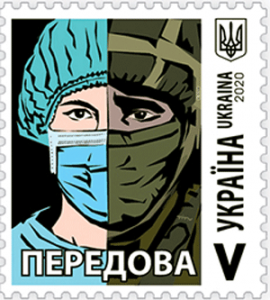 Ukraine issued May 29th a “Frontline” stamp, which appears to honor workers in the battle against COVID-19. The stamp is covers the postage for mailing a letter within Ukraine. The postal agency has also produced a first day cover (shown below) and a maximum card (not shown) for this issue.
Ukraine issued May 29th a “Frontline” stamp, which appears to honor workers in the battle against COVID-19. The stamp is covers the postage for mailing a letter within Ukraine. The postal agency has also produced a first day cover (shown below) and a maximum card (not shown) for this issue.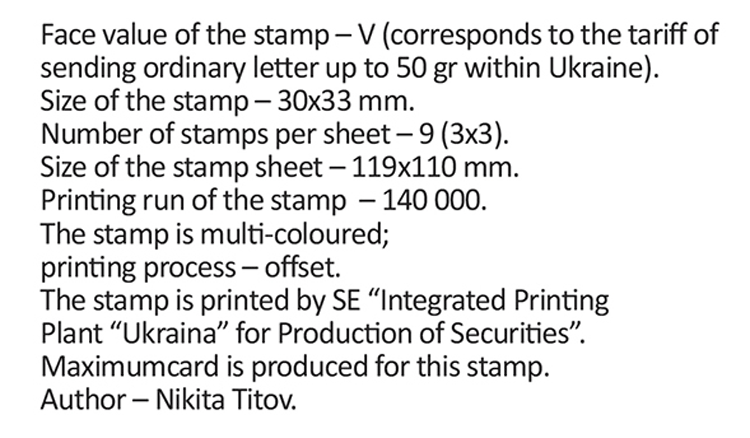
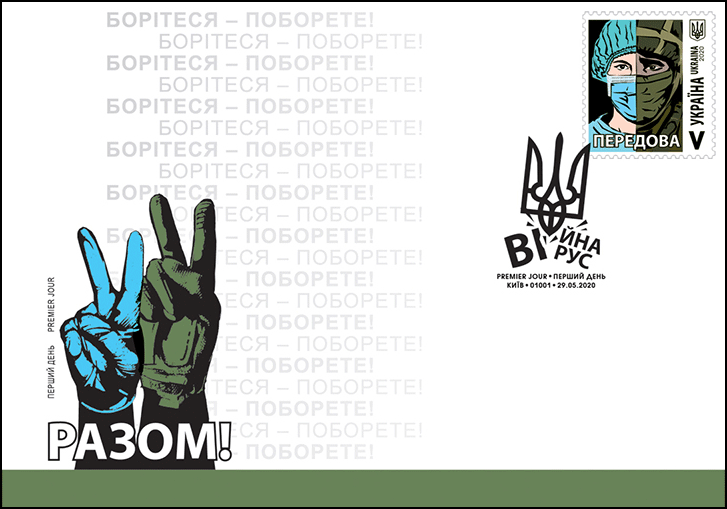
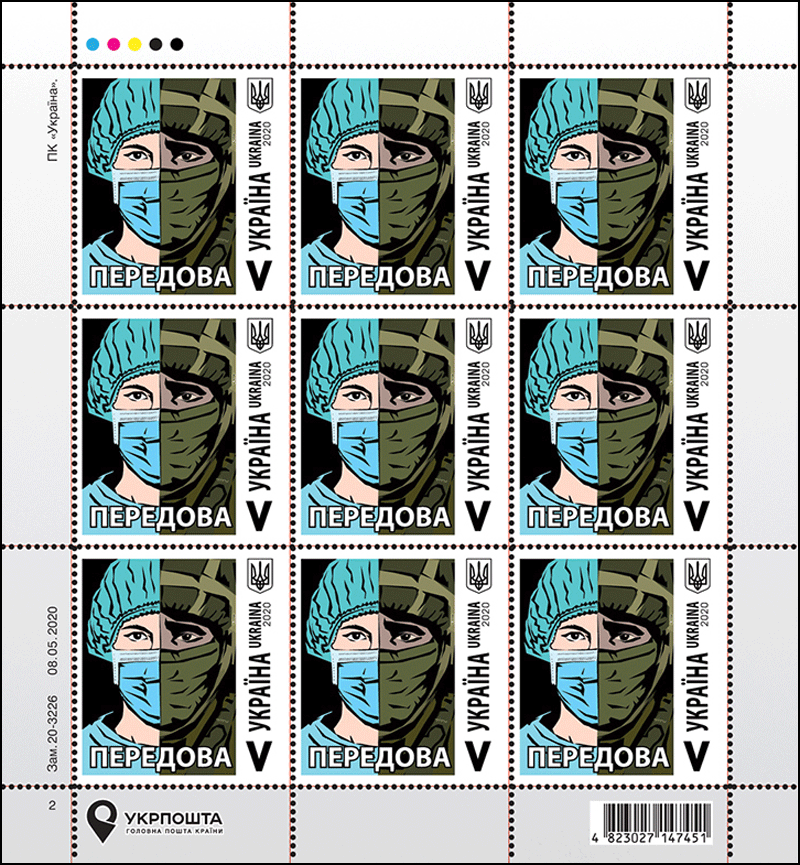
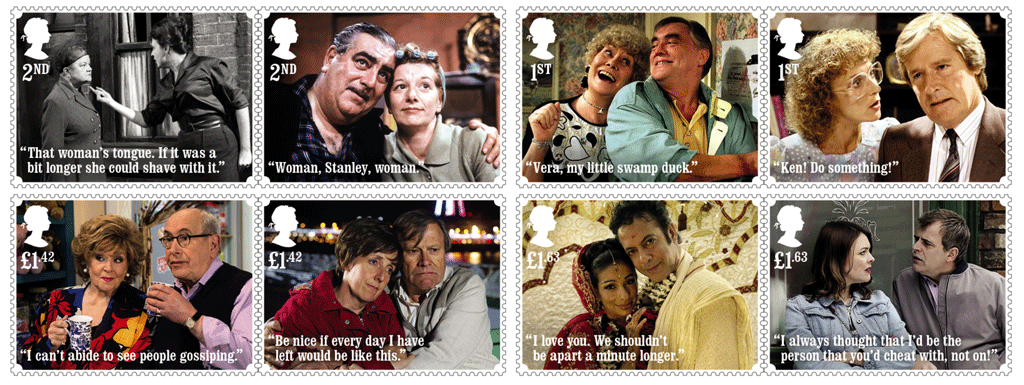
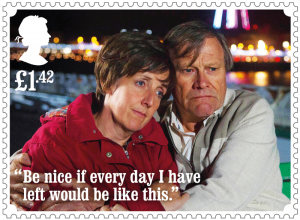 of the world’s longest running TV continuing drama, Coronation Street.
of the world’s longest running TV continuing drama, Coronation Street.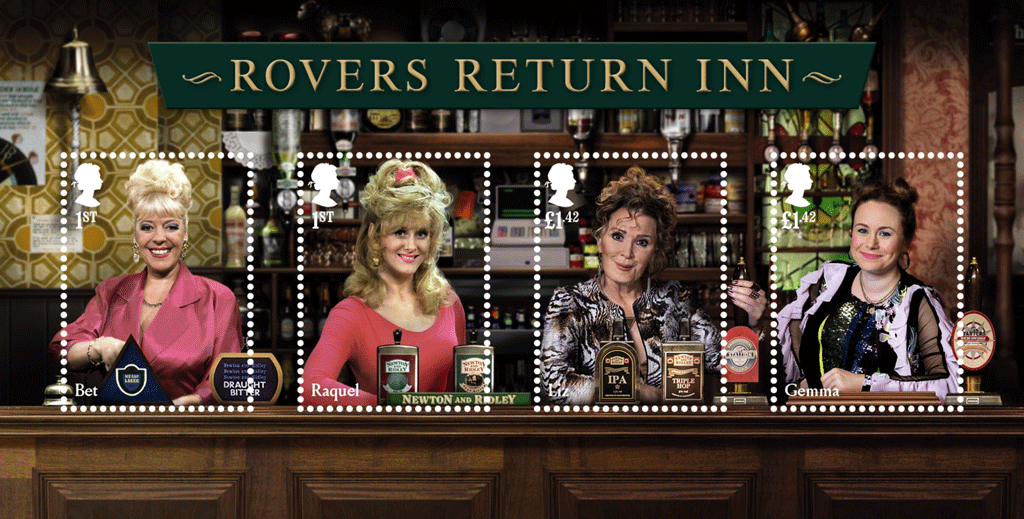
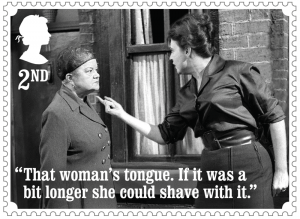 Within months of its first broadcast, which went out live on Friday 9 December 1960, Coronation Street became the country’s most-watched programme and has remained in the top 10 most watched TV shows every week since. The authenticity of its characters and storytelling made ground-breaking British television as the drama portrayed working class lives for the first time on the small screen. Six decades later, the unforgettable storylines and original trademark northern wit are the epicentre of a programme which is now an international hit, selling to over 100 countries.
Within months of its first broadcast, which went out live on Friday 9 December 1960, Coronation Street became the country’s most-watched programme and has remained in the top 10 most watched TV shows every week since. The authenticity of its characters and storytelling made ground-breaking British television as the drama portrayed working class lives for the first time on the small screen. Six decades later, the unforgettable storylines and original trademark northern wit are the epicentre of a programme which is now an international hit, selling to over 100 countries.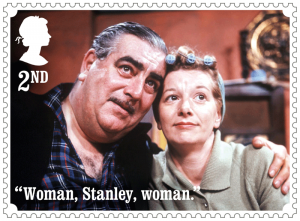 Coronation Street’s iconic characters are now part of British culture – Hilda Ogden despairing of her work-shy hubby Stan, Elsie Tanner and Ena Sharples’ bust-ups, Bet Lynch’s love life, the bond between Roy and Hayley Cropper, Rita and Mavis, the McDonalds, the Barlows and the Alahans… their stories have enthralled fans week after week.
Coronation Street’s iconic characters are now part of British culture – Hilda Ogden despairing of her work-shy hubby Stan, Elsie Tanner and Ena Sharples’ bust-ups, Bet Lynch’s love life, the bond between Roy and Hayley Cropper, Rita and Mavis, the McDonalds, the Barlows and the Alahans… their stories have enthralled fans week after week.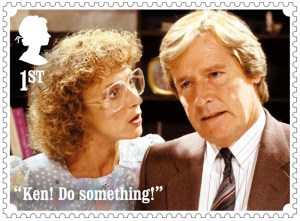 played by William Roache, shown on the right – is still in the cast today, an international achievement noted by Guinness World Records.
played by William Roache, shown on the right – is still in the cast today, an international achievement noted by Guinness World Records.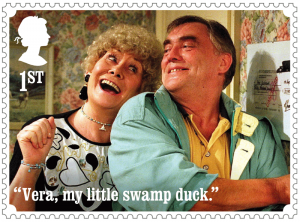 Coronation Street has had many iconic double acts down the years. Indeed, it’s a defining feature of the show. I hope fans will agree that the ones we’ve chosen, after much heated debate, are among the best of the bunch. This fun idea is a great way to pay homage to the nation’s best loved soap and give lovers of Coronation Street a little smile when an envelope pops through their letterbox and they see their favourite characters looking up at them.
Coronation Street has had many iconic double acts down the years. Indeed, it’s a defining feature of the show. I hope fans will agree that the ones we’ve chosen, after much heated debate, are among the best of the bunch. This fun idea is a great way to pay homage to the nation’s best loved soap and give lovers of Coronation Street a little smile when an envelope pops through their letterbox and they see their favourite characters looking up at them. ”
”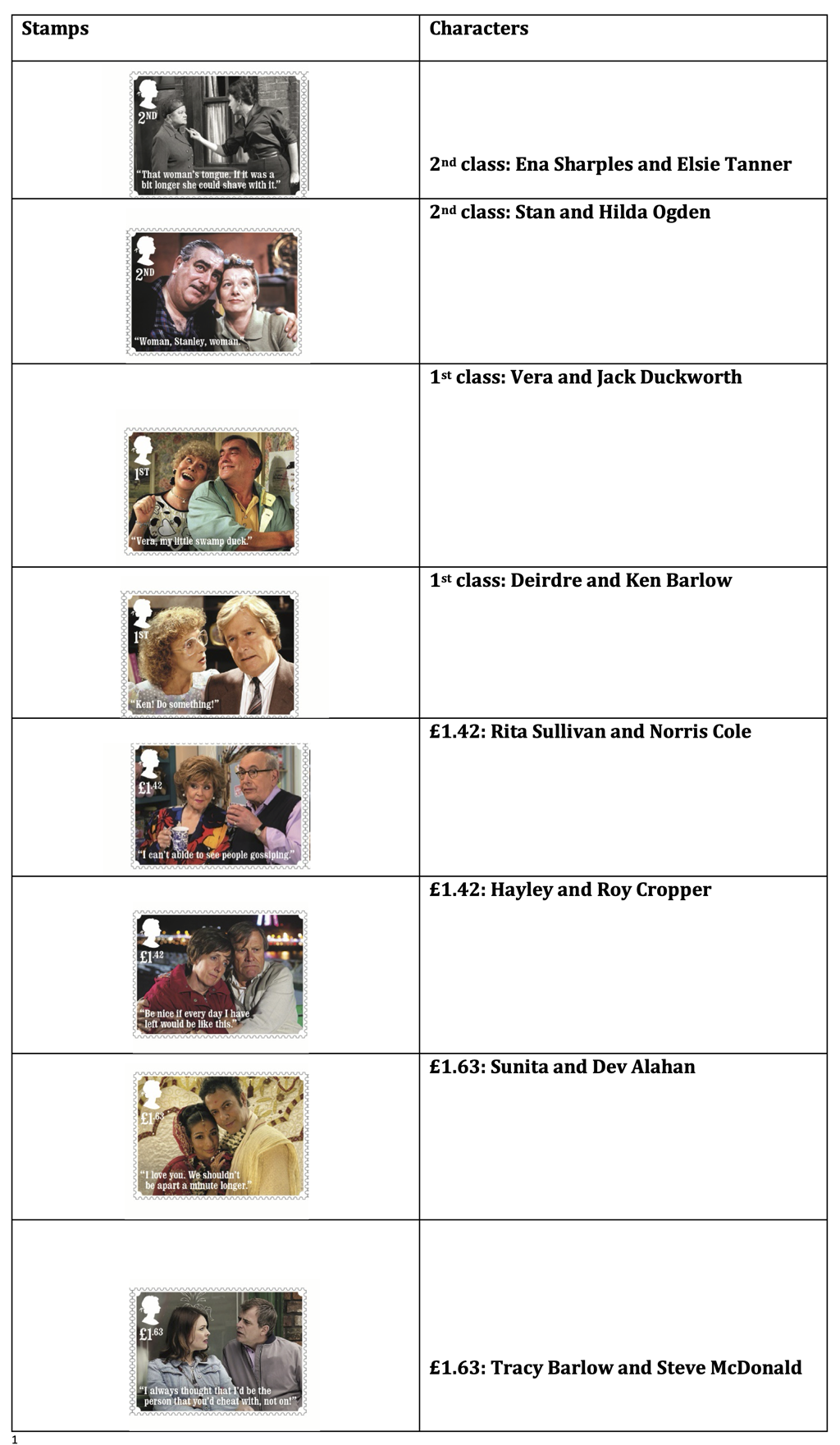
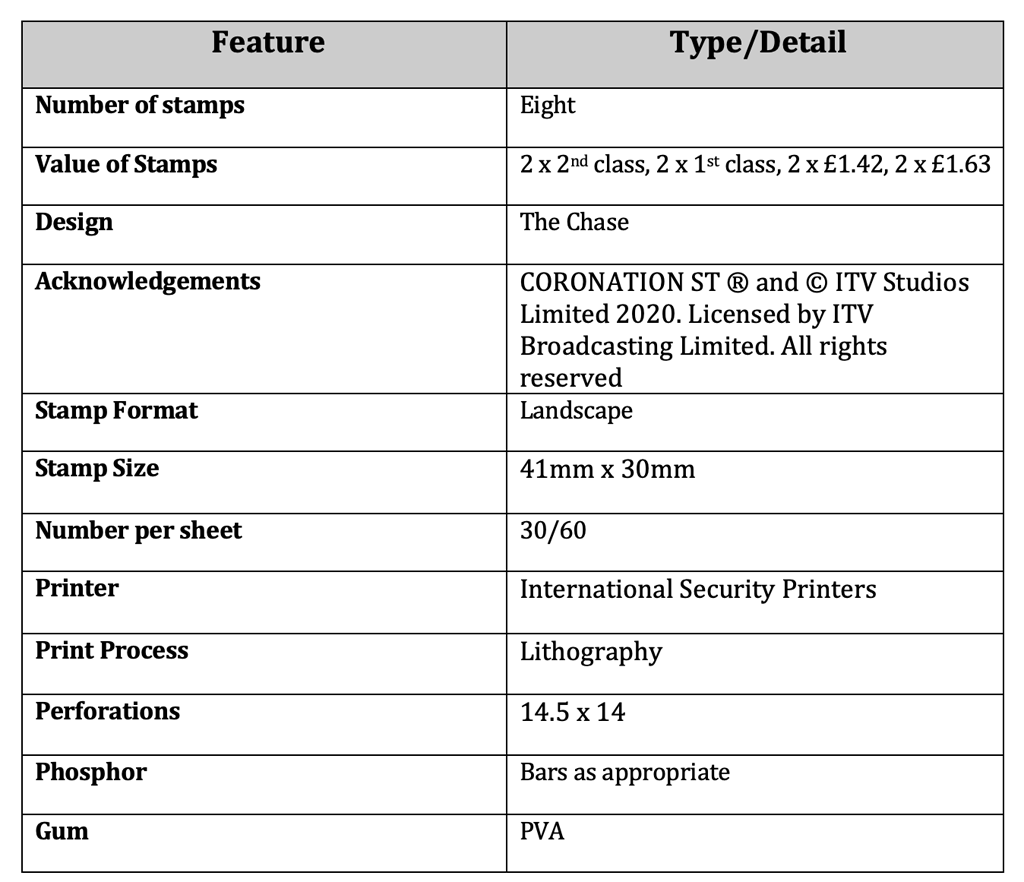
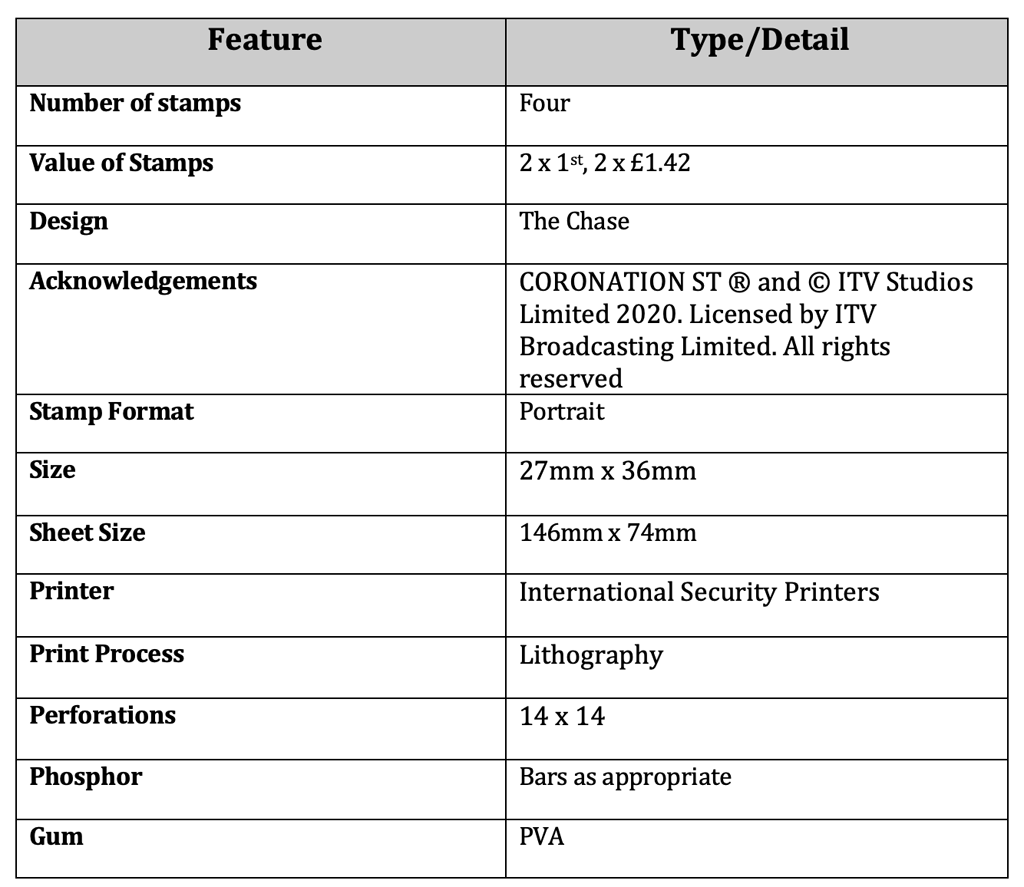
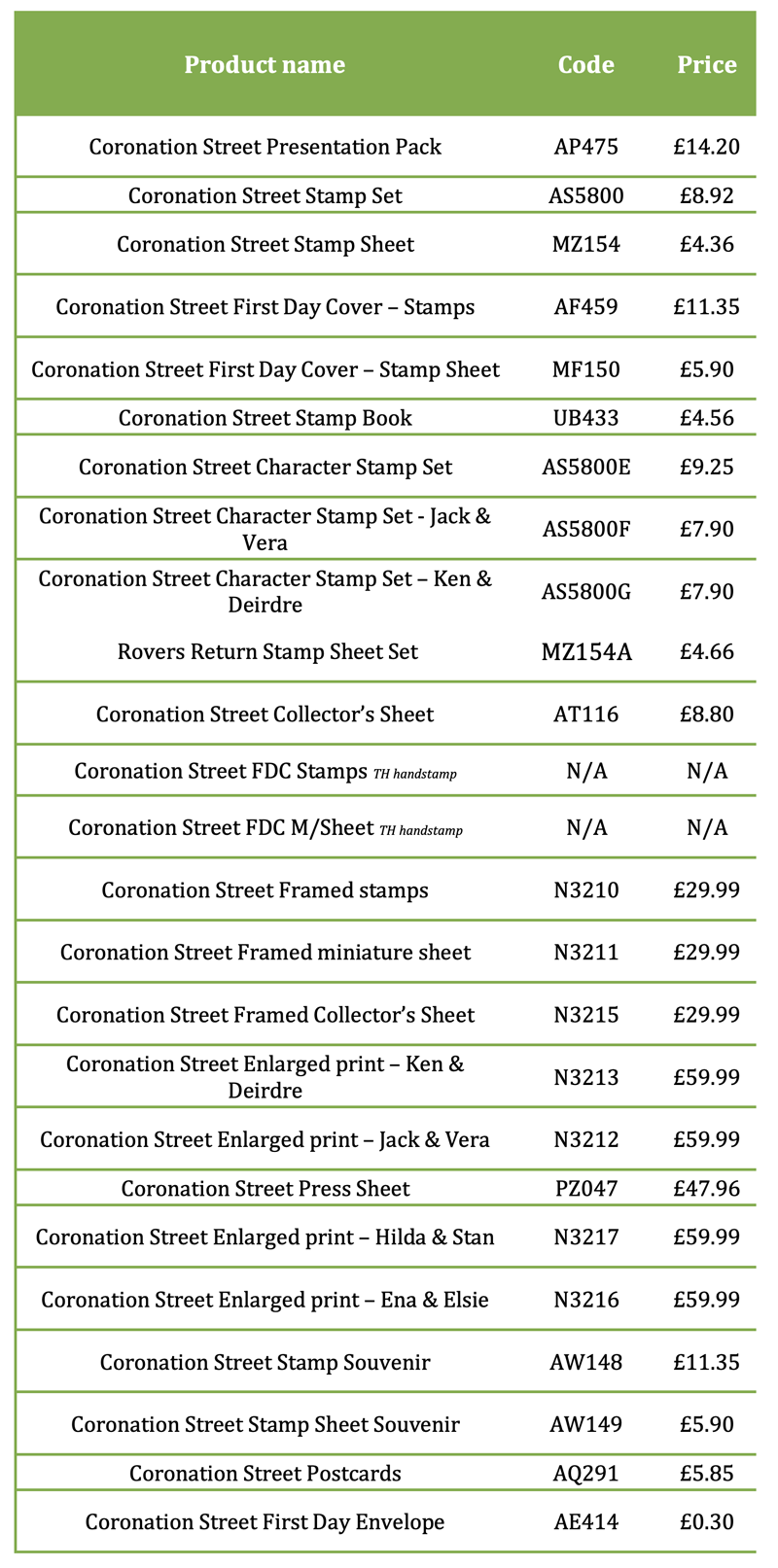
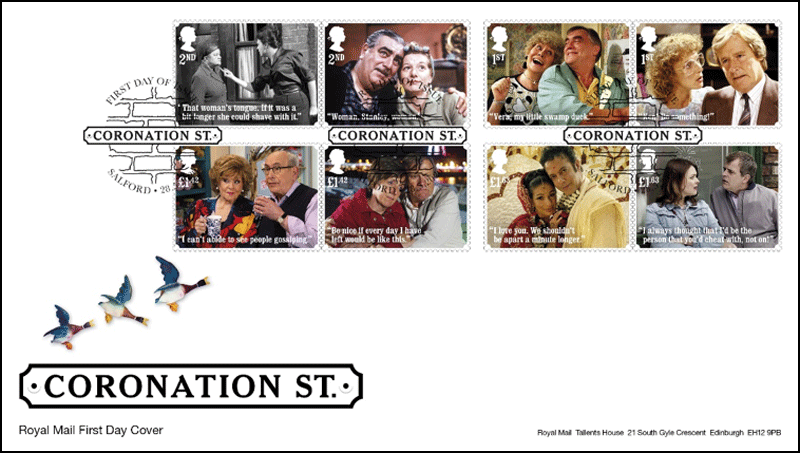 A personalised (will include customer name & address) memento of the day of issue. Includes a filler card (described below) the full set of eight Special Stamps cancelled the with alternative postmark, location being Salford, home to the Coronation Street studios in Manchester. The picture uses the official Coronation Street logo, with the issue date being 28.5.20. The envelope design features the flying ducks, a familiar part of the set design from the early years and now considered a show icon.*Please see note about postmarking & product availability
A personalised (will include customer name & address) memento of the day of issue. Includes a filler card (described below) the full set of eight Special Stamps cancelled the with alternative postmark, location being Salford, home to the Coronation Street studios in Manchester. The picture uses the official Coronation Street logo, with the issue date being 28.5.20. The envelope design features the flying ducks, a familiar part of the set design from the early years and now considered a show icon.*Please see note about postmarking & product availability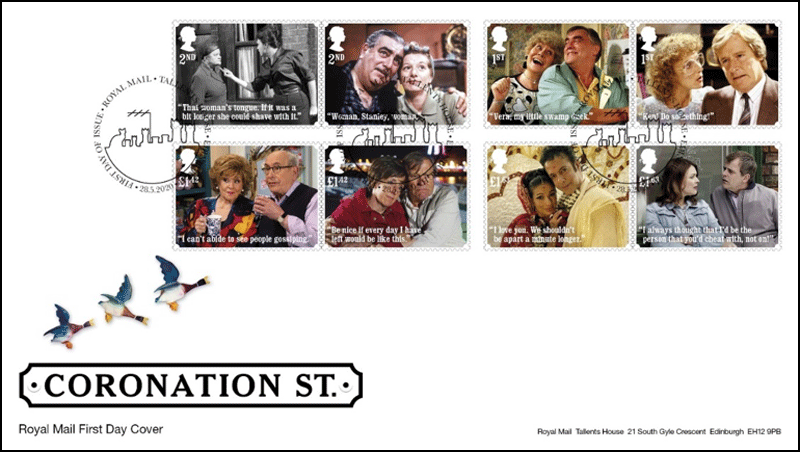 The same as above but with the Tallents House postmark. Again, it includes the filler card and full set of eight Special Stamps cancelled by a handstamp which takes inspiration from the show’s famous title sequence. Location is Tallents House with issue date 28.5.20 *Please see not about postmarking and availability.
The same as above but with the Tallents House postmark. Again, it includes the filler card and full set of eight Special Stamps cancelled by a handstamp which takes inspiration from the show’s famous title sequence. Location is Tallents House with issue date 28.5.20 *Please see not about postmarking and availability.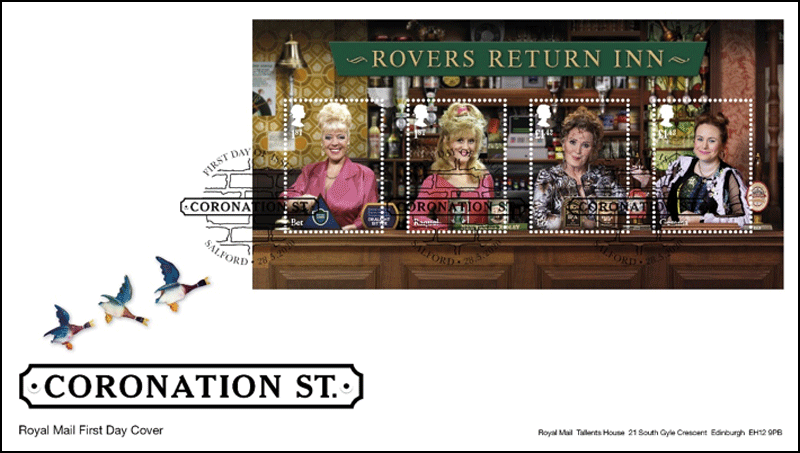 A personalised (will include customer name & address) memento of the day of issue.. Includes a filler card (described above) the stamp sheet, cancelled the with alternative postmark, location being Salford, home to the Coronation Street studios in Manchester. (Envelope & handstamp info same as stamps FDC)
A personalised (will include customer name & address) memento of the day of issue.. Includes a filler card (described above) the stamp sheet, cancelled the with alternative postmark, location being Salford, home to the Coronation Street studios in Manchester. (Envelope & handstamp info same as stamps FDC)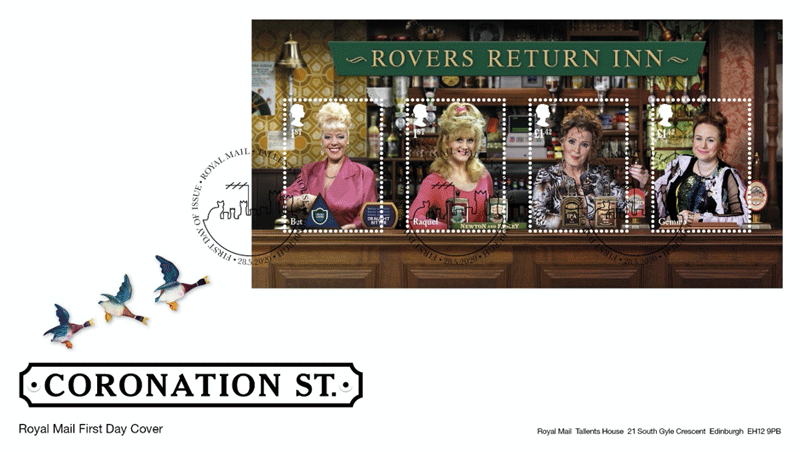 The same as above but with the Tallents House postmark. Again, it includes the filler card and miniature sheet cancelled by a handstamp which takes inspiration from the show’s famous title sequence. Location is Tallents House with issue date 28.5.20 *Please see note about postmarking and availability.
The same as above but with the Tallents House postmark. Again, it includes the filler card and miniature sheet cancelled by a handstamp which takes inspiration from the show’s famous title sequence. Location is Tallents House with issue date 28.5.20 *Please see note about postmarking and availability.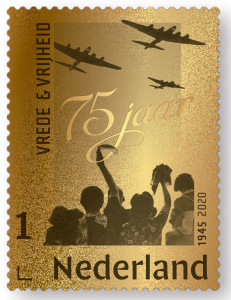 The Hague, May 12, 2020 – Last May 5, the Netherlands celebrated the liberation of our country 75 years ago. Due to the coronavirus, all public events surrounding the May 5 celebration were canceled. Other initiatives can continue, such as the issue by PostNL of a special gold stamp.
The Hague, May 12, 2020 – Last May 5, the Netherlands celebrated the liberation of our country 75 years ago. Due to the coronavirus, all public events surrounding the May 5 celebration were canceled. Other initiatives can continue, such as the issue by PostNL of a special gold stamp.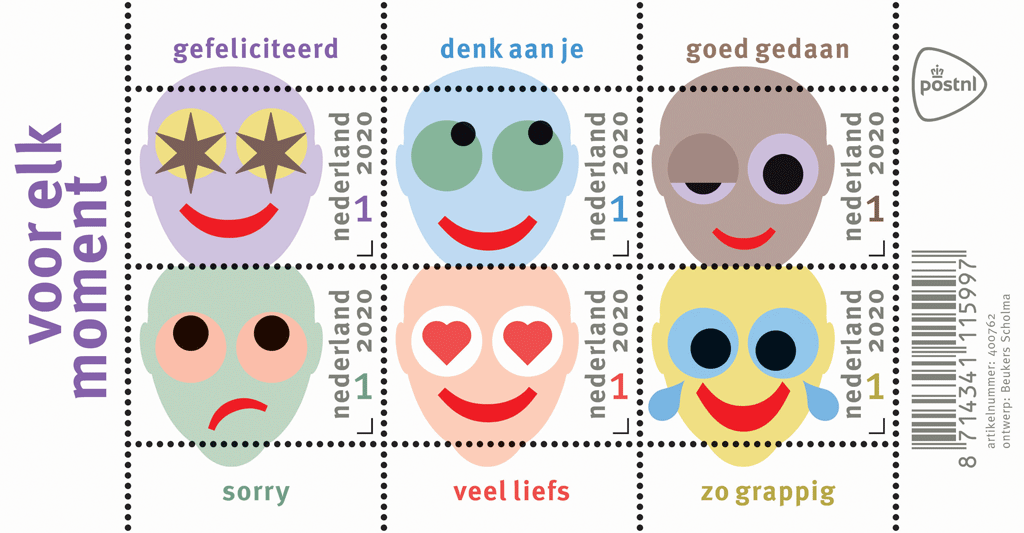
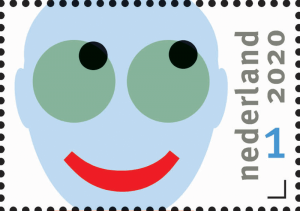 the successor to the occasional postage stamps from 2017.
the successor to the occasional postage stamps from 2017.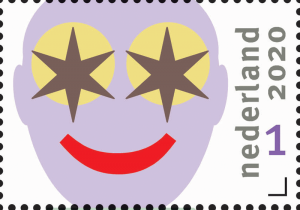 green, red and yellow have large eyes and a red mouth. The look in the eyes matches the accompanying emotion, just like the position of the mouth.
green, red and yellow have large eyes and a red mouth. The look in the eyes matches the accompanying emotion, just like the position of the mouth.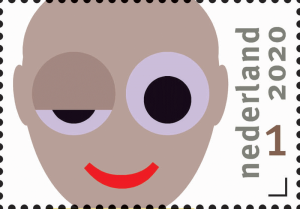 Suitable for any purpose
Suitable for any purpose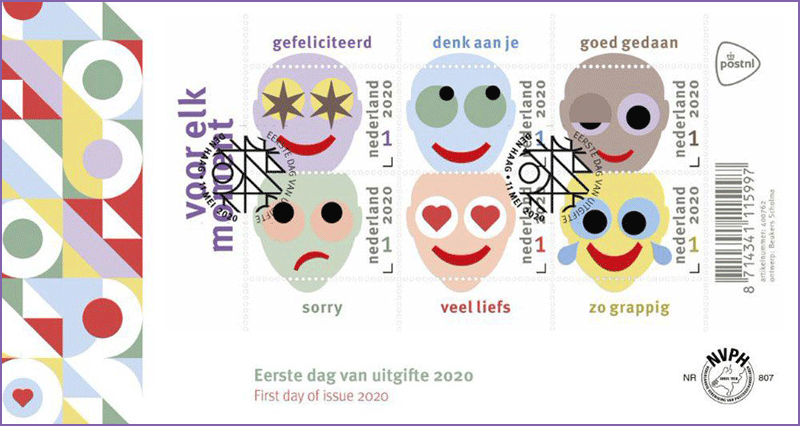
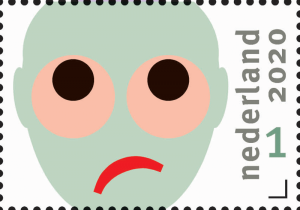 The stamp sheet For each moment there are 6 different stamps with the value indication Nederland 1, intended for mail up to and including 20 grams with a destination within the Netherlands. The stamps will be available from May 11, 2020 at Bruna stores and through the website. The stamps can also be ordered by telephone from the Collect Club customer service on telephone number 088 – 868 99 00. The period of validity is indefinite.
The stamp sheet For each moment there are 6 different stamps with the value indication Nederland 1, intended for mail up to and including 20 grams with a destination within the Netherlands. The stamps will be available from May 11, 2020 at Bruna stores and through the website. The stamps can also be ordered by telephone from the Collect Club customer service on telephone number 088 – 868 99 00. The period of validity is indefinite. 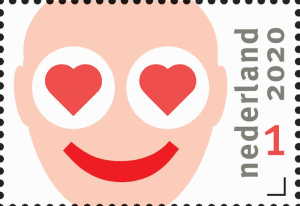
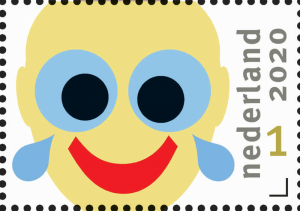
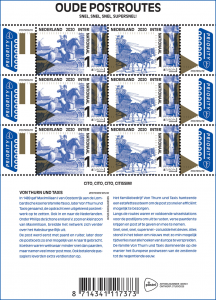 The Hague, May 11, 2020 – For centuries, postal mail was distributed across Europe by postillions on horseback and by stagecoach. PostNL today releases 6 new stamps on which the old postal routes from the Habsburg Empire come to life again.
The Hague, May 11, 2020 – For centuries, postal mail was distributed across Europe by postillions on horseback and by stagecoach. PostNL today releases 6 new stamps on which the old postal routes from the Habsburg Empire come to life again.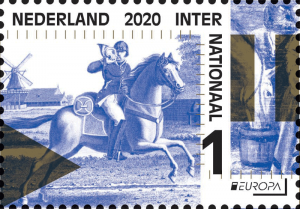 Studio026 from Arnhem has depicted this relay system by Von Thurn und Taxis on the stamp sheet Old Post Routes. The blue images on the stamps show both horses in motion and at rest. The large gold symbols, which follow from left to right with the horses and the stagecoach, also refer to the system of action and rest. There is a thin line with golden stripes between the images that depict the stops along the routes.
Studio026 from Arnhem has depicted this relay system by Von Thurn und Taxis on the stamp sheet Old Post Routes. The blue images on the stamps show both horses in motion and at rest. The large gold symbols, which follow from left to right with the horses and the stagecoach, also refer to the system of action and rest. There is a thin line with golden stripes between the images that depict the stops along the routes.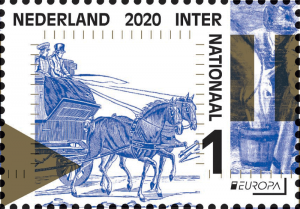 The mail was first transported by horse and rider, later by the stagecoach. Carriages, although slower than horses, took much more mail. Paying passengers also generated extra earnings. The motto for the postal couriers of Von Thurn und Taxis was cito, cito, cito, citissim! In other words: fast, fast, fast, super fast! “The concept was developed based on that credo,” says Anne Schaufeli of studio26. “That’s why the spell is so prominent on the sheet.”
The mail was first transported by horse and rider, later by the stagecoach. Carriages, although slower than horses, took much more mail. Paying passengers also generated extra earnings. The motto for the postal couriers of Von Thurn und Taxis was cito, cito, cito, citissim! In other words: fast, fast, fast, super fast! “The concept was developed based on that credo,” says Anne Schaufeli of studio26. “That’s why the spell is so prominent on the sheet.”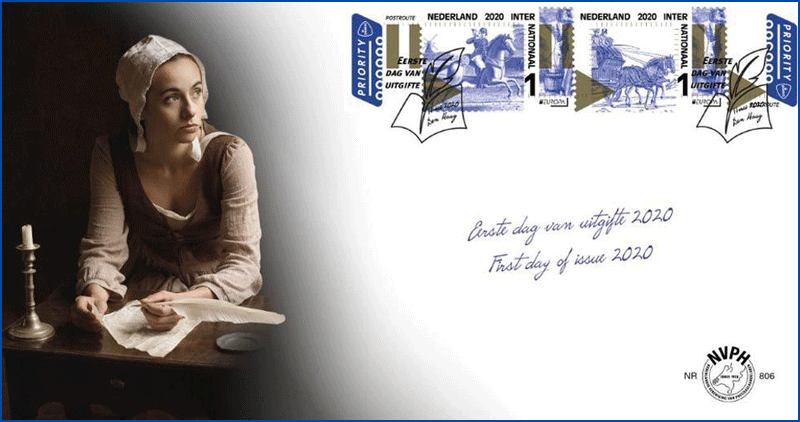
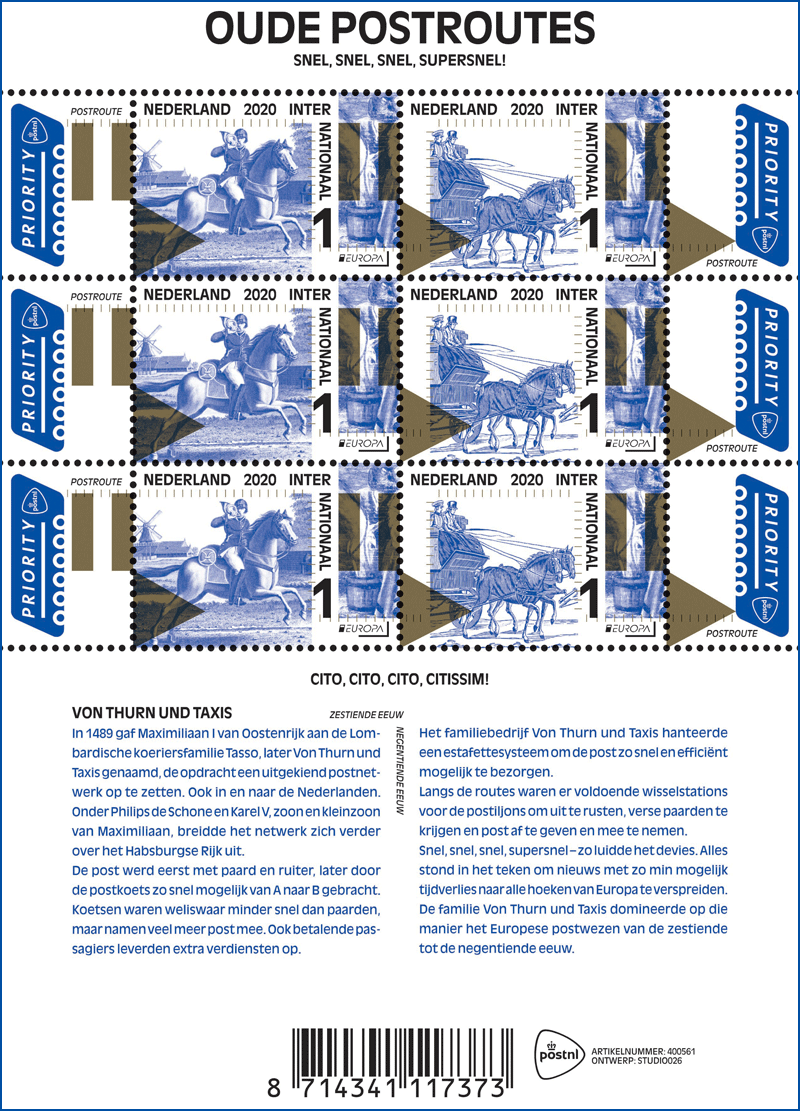
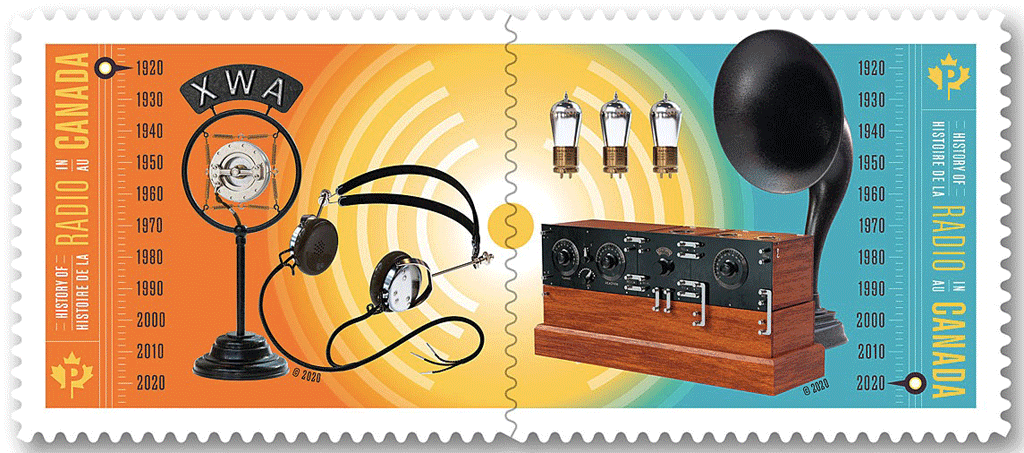
 (Experimental Wireless Apparatus) – the first station in Canada to receive an experimental radio licence. Although the ground-breaking broadcast was transmitted from the Marconi Wireless Telegraph Company of Canada’s factory studio in Montréal to the Naval Radio Service in Ottawa, a receiving station and large amplifier had been set up for the occasion in the hotel’s ballroom.
(Experimental Wireless Apparatus) – the first station in Canada to receive an experimental radio licence. Although the ground-breaking broadcast was transmitted from the Marconi Wireless Telegraph Company of Canada’s factory studio in Montréal to the Naval Radio Service in Ottawa, a receiving station and large amplifier had been set up for the occasion in the hotel’s ballroom.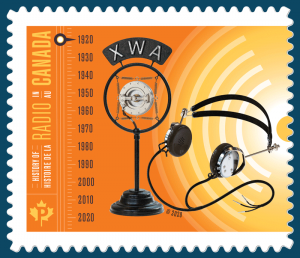 became the first licensed radio station in North America to offer French-language programming. While early enthusiasts were mostly amateurs who built their own equipment, radio caught on quickly with mainstream listeners. Within two years of Canada’s historic first broadcast, 34 radio stations were operating across the country. By the end of the decade, Canadians were tuning in on more than 300,000 radios.
became the first licensed radio station in North America to offer French-language programming. While early enthusiasts were mostly amateurs who built their own equipment, radio caught on quickly with mainstream listeners. Within two years of Canada’s historic first broadcast, 34 radio stations were operating across the country. By the end of the decade, Canadians were tuning in on more than 300,000 radios.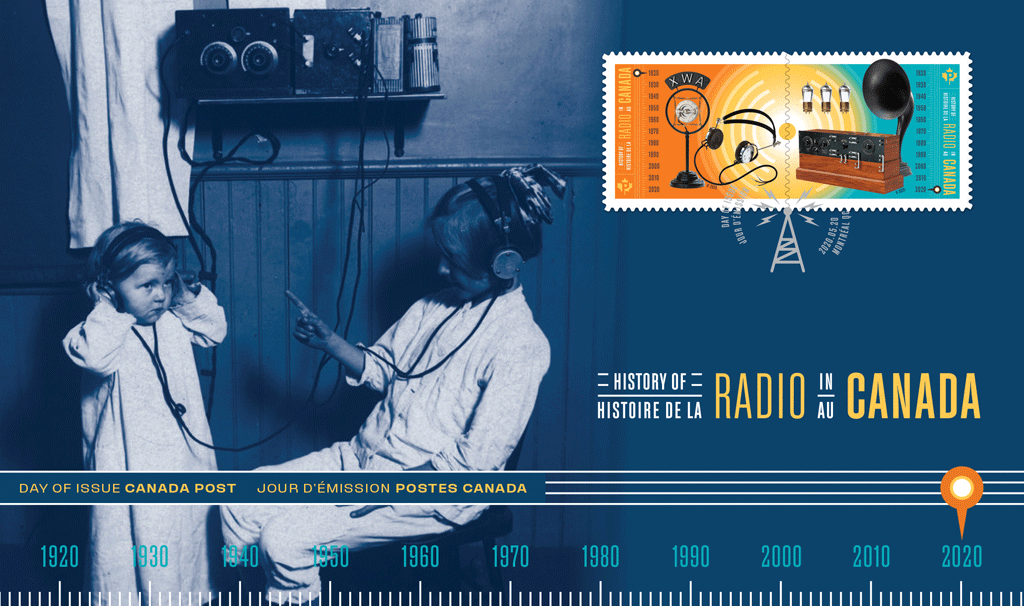
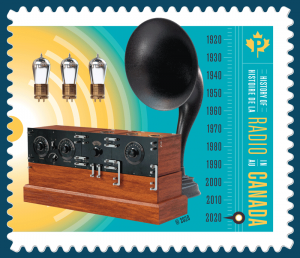 Although the groundbreaking broadcast was transmitted from the Montréal studios to the Naval Radio Service in Ottawa, a receiving station and large amplifier had been set up for the occasion at the Château Laurier hotel. As reported in the Ottawa Journal by one of the journalists invited to listen in, when “the latest one-step” was played, the clarity was so impressive that several of the newspaper writers began to dance.
Although the groundbreaking broadcast was transmitted from the Montréal studios to the Naval Radio Service in Ottawa, a receiving station and large amplifier had been set up for the occasion at the Château Laurier hotel. As reported in the Ottawa Journal by one of the journalists invited to listen in, when “the latest one-step” was played, the clarity was so impressive that several of the newspaper writers began to dance.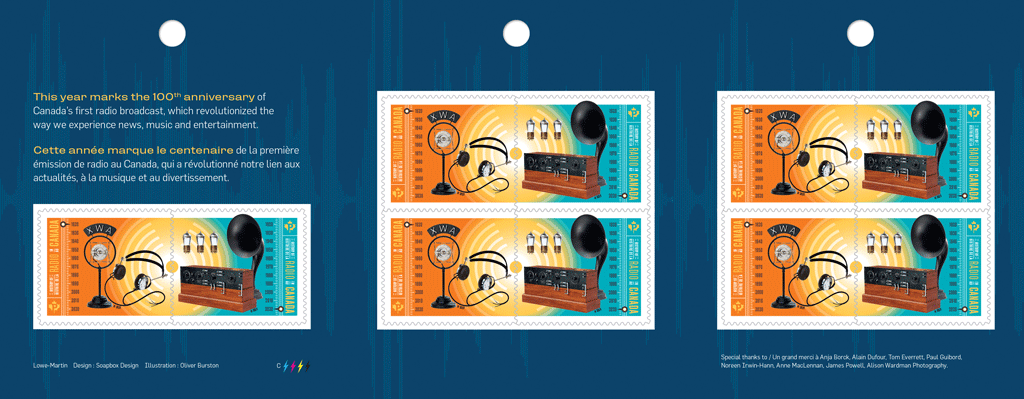 To create a stamp depicting the earliest days of radio, for which there was little original imagery available, Canada Post assembled a team of experts from academia, communications museums and vintage radio clubs to ensure visual accuracy and an authentic back story.
To create a stamp depicting the earliest days of radio, for which there was little original imagery available, Canada Post assembled a team of experts from academia, communications museums and vintage radio clubs to ensure visual accuracy and an authentic back story.


